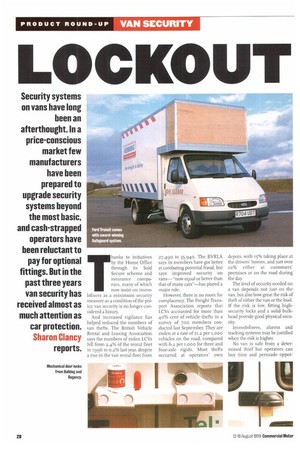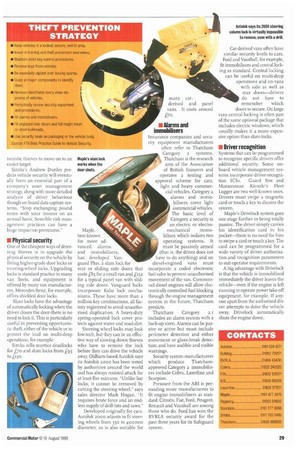Security systems on vans have long been an afterthought. In
Page 30

Page 31

If you've noticed an error in this article please click here to report it so we can fix it.
a price-conscious market few manufacturers have been prepared to upgrade security systems beyond the most basic, and cash-strapped operators have been reluctant to pay for optional fittings. But in the past three years van security has received almost as much attention as car protection. Sharon Clancy reports.
Thanks to initiatives by the Home Office through its Sold Secure scheme and insurance companies, many of which now insist on immobilisers as a minimum security measure as a condition of the policy, van security is no longer considered a luxury.
And increased vigilance has helped reduced the numbers of van thefts. The British Vehicle Rental and Leasing Association says the numbers of stolen LCVs fell from 2.4% of the rental fleet in 1996 to 0.2% last year, despite a rise in the van rental fleet from 27,490 to 35,940. The BVRLA says its members have got better at combating potential fraud, but says improved security on vans— now equal or better than that of many cars"—has played a major role.
However, there is no room for complacency. The Freight Transport Association reports that LCVs accounted for more than 40% cent of vehicle thefts in a survey of 700 members conducted last September. They are stolen at a rate of 11.2 per i,000 vehicles on the road, compared with 6.2 per 1, 000 for three and four-axle rigids. Most thefts occurred at operators' own
depots, with 15% taking place at the drivers' homes, and just over io% either at customers' premises or on the road during the day.
The level of security needed on a van depends not just on the van, but also how great the risk of theft of either the van or the load. If the risk is low, fitting highsecurity locks and a solid bulkhead provide good physical security.
Immobilisers, alarms and tracking systems may be justified when the risk is higher.
No van is safe from a determined thief but operators can buy time and persuade oppor tunistic thieves to move on to an easier target.
Simba's Andrew Dunley predicts vehicle security will eventually form an essential part of a company's asset management strategy, along with more detailed analysis of driver behaviour though on-board data capture systems. "Stop exchanging pound notes with your insurer on an annual basis. Sensible risk management practices can have a huge impact on premiums."
• Physical security
One of the cheapest ways of deterring thieves is to upgrade the physical security on the vehicle by fitting higher-grade door locks or steering-wheel locks. Upgrading locks is standard practice in many van fleets, and equipment is offered by many van manufacturers. Mercedes-Benz, for example, offers shielded door locks.
Slam locks have the advantage of automatically locking when the driver closes the door-there is no need to lock it. This is particularly useful in preventing opportunistic theft, either of the vehicle or to protect the load on multi-drop operations, for example.
Sirnba sells rnortice deadlocks for £70 and slam locks from L95 to Li3o. Maple, best-known for more advanced alarms and immobilisers, has developed Vanguard Plus, a slam lock for rear or sliding side doors that costs £85 for a small van and £152 for a typical panel van with sliding side doors. Vanguard locks incorporate Kaba lock mechanisms. These have more than a million key combinations, all factory registered to avoid unauthorised duplication. A heavy-duty spring-operated lock cover proteas against water and road-dirt.
Steering wheel locks may look low-tech, but they can be an effective way of slowing down thieves who have to remove the lock before they can drive the vehicle away. Oldham-based Autolok says its Autolok 2000 has been tested by authorities around the world and has always resisted attack for at least five minutes. "Unlike bar locks, it cannot be removed by cutting the steering wheel," says sales director Mark Hogan. "It requires brute force and an endless supply of drill-bits and saws."
Developed originally for cars, Autolok 2000 adjusts to fit steering wheels from 350 to 400mm diameter, so is also suitable for
many car derived and panel vans. It costs around
£70.
• Alarms and immobilisers
Insurance companies and security equipment manufacturers often refer to Thatcham Category 2 systems. Thatcham is the research arm of the Association of British Insurers and
operates a testing and approval scheme for cars, light and heavy commercial vehicles. Category 2 alarms arid immobilisers cover light commercial vehicles. The basic level of Category 2 security is an electric or electro mechanical immobiliser, which isolates two operating systems. It must be passively armed (that is, the driver does not have to do anything) and on diesel-engined vans must incorporate a coded electronic fuel valve to prevent unauthorised movement of the van. Commonrail diesel engines will allow electronically controlled fuel blocking through the engine management system in the future, Thatcham predicts.
Thatcham Category 2.I includes an alarm system with a back-up siren. Alarms can be passive or active but must include perimeter detection and either movement or glass-break detection; and have audible and visible warnings.
Security system manufacturers which produce Thatchamapproved Category 2 immobilisers include Cobra, Laserline and Scorpion.
Pressure from the ABI is persuading more manufacturers to fit engine immobilisers as standard. Citroen, Fiat, Ford, Peugeot, Renault and Vauxhall are among those who do. Ford has won the BVRLA security award for the past three years for its Safeguard system.
Car-derived vans often have similar security levels to cars. Ford and Vauxhall, For example, fit immobilisers and central locking as standard. Central locking can be useful on multi-drop operations and on vans with side as well as rear doors—drivers do not have to remember which doors to secure. On large vans central locking is often part of the same optional package that includes electric windows, which usually makes it a more expensive option than slam-locks.
• Driver recognition Systems that can be programmed to recognise specific drivers offer additional security. Some onboard vehicle management systems incorporate driver-recognition ICSs. Guard Box and Mannesrnan Kienzle's Fleet Logger are two well-known ones. Drivers must swipe a magnetic card or touch a key to disarm the system.
Maple's Drivelock system goes one stage further in being totally passive. The driver simply carries his identification card in his pocket—there is no need for him to swipe a card or touch a key. The card can be programmed for a wide variety of driver authorisation and recognition parameters to suit operator requirements.
A big advantage with Drivelock is that the vehicle is immobilised immediately the driver leaves the vehicle—even if the engine is left running to operate power take-off equipment, for example. If anyone apart from the authorised driver attempts to drive the vehicle away, Drivelock automatically shuts the engine down.








































































































